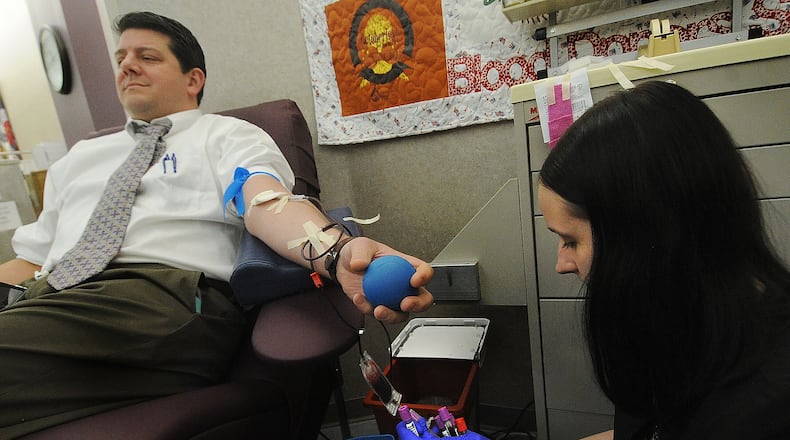Pompilio said some regions reported a 50% decline in business-hosted blood drives in 2022 from 2019 and about a 20% decline in donors in the last three years. He said the Dayton area saw blood usage and donor participation rise and fall dramatically, as well as a shift from large corporate and high school blood drives to smaller blood drives with higher frequency.
As the pandemic eased, demand for blood continued to rise at the hospitals within the center’s service area, which expanded from 15 to 18 counties, including Allen and Mercer counties.
The center is still gaining new donors, but they are not gaining donors at the same rate they were prior to the pandemic, Pompilio said. From 2018 to 2019, the one year increase in number of people who registered to donate whole blood was approximately 5,000 registrations. From 2019 to 2022, that three-year increase was approximately 7,000 donors.
These concerns are often cited in discussions of safely easing restrictions related to Mad Cow disease and individual risk behavior.
“I feel the pandemic, and the blood shortage which was a result, forced the blood industry to reevaluate itself and look for safe opportunities to allow more folks to gain eligibility,” said Gavin Patch of the Community Blood Center.
He said the adoption of certain kinds of testing has improved the detection and identification of HIV and hepatitis, which have improved the safety of red blood cell, plasma, and platelet products for patients throughout the U.S.
Changes proposed on time deferrals
The U.S. FDA recently proposed removing limitations on blood donations that previously impacted mainly the LGBT community, particularly gay and bisexual men, instead putting in place gender-inclusive, individual risk-based questions to reduce the risk of transfusion-transmitted HIV.
The FDA is proposing eliminating time-based deferrals for men who have sex with men (MSM) and women who have sex with MSM. The blood donor history questionnaire would be revised to ask all prospective donors about new or multiple sexual partners in the past three months.
“Whether it’s for someone involved in a car accident, or for an individual with a life-threatening illness, blood donations save lives every day,” said FDA commissioner Dr. Robert M. Califf. “Maintaining a safe and adequate supply of blood and blood products in the U.S. is paramount for the FDA, and this proposal for an individual risk assessment, regardless of gender or sexual orientation, will enable us to continue using the best science to do so.”
Under an individual risk model in the proposed guidance, all donors will be asked whether they have had new or multiple partners over the last three months. In addition, all donors will be asked questions regarding their medical history, including questions specific to increased HIV risk. Depending on the answers to these questions, potential donors may be deferred.
“The changes are only proposals at this time. In general, the proposals move away from deferring individuals because they belong to a group and move toward asking the individual if there are behaviors that increase their risk of having a transmissible infectious disease. The specific questions that will be on the final questionnaire have not been finalized,” said Dr. James Alexander, medical director of the Dayton Community Blood Center and Community Tissue Services.
‘A step in the right direction’
These proposed changes are undergoing a 60-day comment period within the health care and blood collection industry, but community members are supportive of changes that could allow additional donors to give blood.
Adam Webber of Kettering regularly donates blood at the Dayton Community Blood Center, donating four to five times a year since he was a teenager. He said hopefully the changes would allow more individuals to donate.
“I’m for it,” Webber said on Monday at the Dayton Community Blood Center. “There shouldn’t be a stigma attached to certain classes of people, and having more possible donors is a good thing.”
Rick Flynn, executive director of the Greater Dayton LGBT Center, said this proposed change in the donor eligibility was “a step in the right direction.”
“I think it’s a good thing. It’s about time, and I think the ban—while I understand why it was initially done because there was very little we knew about HIV and that’s what they were trying to avoid—I think that it’s always been a discriminatory practice because men who sleep with men still want to be part of the greater community,” Flynn said. When individuals aren’t able to donate blood following a tragedy or as part of a blood drive because of those deferrals, he said, “It becomes embarrassing and humiliating.”
Eligibility opened up for travelers
This proposal is in line with policies in place in countries like the United Kingdom and Canada, the FDA said. It also follows the change the FDA has approved to remove bans on individuals who traveled in Europe in the 1980s and 1990s in regard to possible exposure to Mad Cow disease.
Changes in the criteria now allow the following groups to donate: people who spent time in the U.K. from 1980-1996, people who spent time in France and Ireland from 1980-2001, and people who received a blood transfusion in the U.K., France, and Ireland from 1980-present.
“The updated guidance related to Mad Cow disease is an opportunity to expand our donor base during a challenging time for our regional blood supply,” said Alexander.
In addition to prescreening blood donors, blood donations undergo multiple tests after being collected. Donations are tested for multiple types of infectious diseases and viruses, like HIV, the human immunodeficiency virus that causes AIDS.
For more information on blood donations and how to give blood, visit the Community Blood Center’s website at cbccts.org.
About the Author

